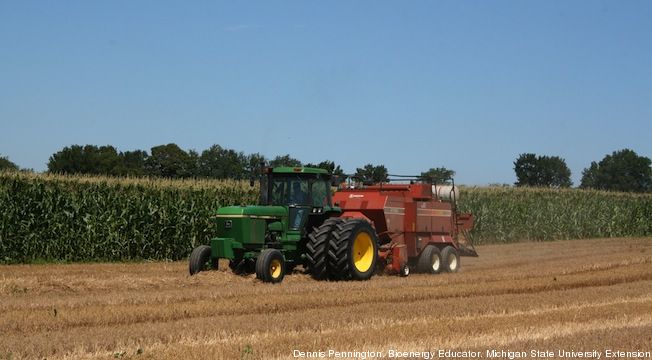Small solar-panel installations have allowed homeowners to lower carbon emissions, and perhaps save some money on electricity as well.
Electric-car drivers with home solar installations can also further decrease the carbon footprint of a vehicle by charging it using solar power.
Solar has become a popular enough option that some analysts believe "distributed" energy generation from individual home systems could soon become a viable option to grid electricity.
DON'T MISS: As Solar Installations Soar, Utilities Confront Distributed Renewable Power
But solar isn't the only renewable-energy source available, of course.
Wind turbines have been largely inaccessible to individual users, but that is changing, according to The New York Times (subscription required).
A startup called United Wind is applying the rooftop solar-panel model to wind turbines, leasing system to customers with no upfront costs.

Big square baler harvesting wheat straw for production of cellulosic ethanol
The company's 10 to 100-kilowatt turbines are much smaller than the colossal machines used on commercial wind farms.
These smaller turbines have been available for some time, but United Wind's leasing model is believed to be a potential breakthrough in their mainstream adoption.
ALSO SEE: Wind, Natural Gas, Solar Provide More U.S. Power, Replacing Coal
United Wind is currently targeting rural homes, farms, and small business with enough wind and space--and high enough electricity demands--to make an installation worthwhile financially.
Rural users are also less likely to encounter community opposition to the installation of a wind turbine.
Mounted on open-lattice towers, the turbines aren't as imposing as larger commercial ones, but they may still cause some visual obstruction and noise that could bother neighbors.

Wind farm, by Flickr user Patrick Finnegan (Used under CC License)
Customers reportedly see savings of at least 10 percent over a public utility, and can save more by prepaying all or part of a contract.
This allows them to avoid annual rate increases--something also built into solar leases--of 1.9 percent, in United Wind's case.
MORE: Long-Lived Clean Power: Wind Turbines Last 25 Years, Study Says (Feb 2014)
A typical homeowner could save $20,000 and a typical farm could save $200,000 over the period of a lease, generally 20 years.
The savings created by this lease model have some analysts feeling confident about small and medium wind turbines.
Global revenue from turbines of under 500 kW will grow $1 billion in in 2015 to nearly $2.4 billion in 2023, according to Navigant Research,
However, most of that revenue will come from other markets, with the U.S. expected to account for just $216 million of the 2023 total.
_______________________________________________












